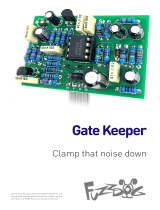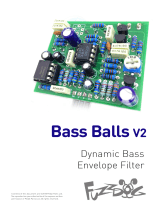Page is loading ...

Quiet Boost
All the oomph -
none of the crackle
Contents of this document are ©2017 Pedal Parts Ltd.
No reproduction permitted without the express written
permission of Pedal Parts Ltd. All rights reserved.

Schematic + BOM
R1 5K1
R2 2M2
R3 2M2
R4 100K
R5 2k2 (CLR)
R6 1M
C1 100n
C2 47u electrolytic
C3 10u electrolytic
D1 1N4001
D2 12V Zener
Q13 BS170
GAIN 1MB

The power and signal pads on the PCB
conform to the FuzzDog Direct Connection
format, so can be paired with the
appropriate daughterboard for quick and
easy offboard wiring. Check the separate
daughterboard document for details.
Be very careful when soldering the diodes
and transistor. They’re very sensitive to
heat. You should use some kind of heat
sink (crocodile clip or reverse action
tweezers) on each leg as you solder them.
Keep exposure to heat to a minimum
(under 2 seconds).
Snap the small metal tag off the pot so it
can be mounted flush in the box. Pot
mounts on the same side of the PCB as
the other components, and should be
soldered in place last.
Positive (anode) legs of the electrolytic
caps go to the square pads.
Negative (cathode) legs of the diodes go to
the square pad.
WHASSIT?
Everyone loves a Super Hard-On. Yes,
even you. Admit it. But that crackle....
Sounds like your amp is giving out every
time you touch that knob.
So here’s a boost that sounds almost
exactly the same but doesn’t make you
cringe when adjusting.
Designed by SoulSonic. Many thanks.
PCB layout ©2017 Pedal Parts Ltd.

Test the board!
UNDER NO CIRCUMSTANCES will troubleshooting help
be offered if you have skipped this stage. No exceptions.
Once you’ve finished the circuit it makes sense to test is before starting on the switch and
LED wiring. It’ll cut down troubleshooting time in the long run. If the circuit works at this
stage, but it doesn’t once you wire up the switch - guess what? You’ve probably made a
mistake with the switch.
Solder some nice, long lengths of wire to the board connections for 9V, GND, IN and OUT.
Connect IN and OUT to the jacks as shown. Connect all the GNDs together (twist them up
and add a small amount of solder to tack it). Connect the battery + lead to the 9V wire,
same method. Plug in. Go!
If it works, crack on and do your switch wiring. If not... aw man. At least you know the
problem is with the circuit. Find out why, get it working, THEN worry about the switch etc.
BATTERY
IN OUT
Your nice, new circuit board
INCLUDING WIRED POTS!!!!
IN 9V GND OUT

Wiring shown above will disconnect the battery when you remove the jack plug
from the input, and also when a DC plug is inserted.
The Board GND connections don’t all have to directly attach to the board. You
can run a couple of wires from the DC connector, one to the board, another to
the IN jack, then daisy chain that over to the OUT jack.
It doesn’t matter how they all connect, as long as they do.
This circuit is standard, Negative GND. Your power supply should be Tip
Negative / Sleeve Positive. That’s the same as your standard pedals (Boss etc),
and you can safely daisy-chain your supply to this pedal.
L
E
D
BOARD
OUT
BOARD
9V
BOARD
GND
BOARD
GND
BOARD
GND
BOARD
INPUT
BATTERY
+
IN
OUT
L
E
D
BOARD
GND
BOARD
LED+
+
Wire it up (if using a daughterboard please refer to the relevant document)

This template is a rough guide only. You should ensure correct marking of your
enclosure before drilling. You use this template at your own risk.
Pedal Parts Ltd can accept no responsibility for incorrect drilling of enclosures.
FuzzDog.co.uk
Drilling template
Hammond 1590B
60 x 111 x 31mm
It’s a good idea to drill the pot and
toggle switch holes 1mm bigger if
you’re board-mounting them.
Wiggle room = good!
Recommended drill sizes:
Pots 7mm
Jacks 10mm
Footswitch 12mm
DC Socket 12mm
Toggle Switch 6mm
/









